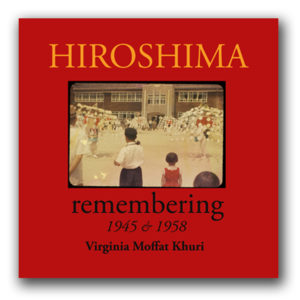Hiroshima by Virginia Moffat Khuri


![]()
Remembering, 1945 & 1958
The book tells two parallel stories. The first, on the morning of August 6, 1945 the United States dropped an atomic bomb on the city of Hiroshima. The second, on the morning of August 6, 1958 an American teenager spoke from the Children’s Memorial in the peace Park to the people of Hiroshima and the youth of Japan – and the world. These two ‘stories’ mirror each other on opposite pages: one an image, the other words, which somehow relate to each other. The first story is one of horror; the second, one of hope for peace on earth.
The images are from transparencies were made by an exchange student to Hiroshima in 1958. They were taken by a 16 year old with no photographic experience using a borrowed 35mm camera lacking a light meter, auto-focus and film that had to be loaded into cartridges before leaving home. They were badly stored in an attic for 50 years and were so damaged that they were almost thrown away. But the light leaks and emulsion cracks might be reminiscent of the Atomic bombing thirteen years earlier and the dust could also be seen as the Black Rain that caused radiation sickness. Even the mundane street scenes caught on a bright sunny morning mirrored August 6, 1945.
The marriage of photographs and text can often be problematic where the images ‘illustrate’ the words, but Khuri has realised that the tension between both gives a telling and poignant counterpoint to the overall narrative. The distressed quality of the 60 years old colour transparencies complements the stories of destroyed lives, and the emotive and eloquent content of this outstanding and sensitive book work. The sentiments expressed in this work are just as relevant today as they were when Khuri was making her first tentative teenage steps into photography in 1958. —Professor Paul Hill MBE, FRPS, DFine Art, Visiting Professor, University of Derby & De Montfort University, Leicester,UK
A timely personal reflection with testimonies to the human and material devastation and horror of the atomic bomb applied as a weapon in human conflict.—William Bishop, Editor of Inscape photography magazine
It’s an amazing book. The bitter contrast between the soft-colored street scenes and the horror of the text! So powerful, so painful! It is a brilliant melange of still alive and lovely and those who died in so many forms of agony. If anything will make we who still live aware of what could so well be, it is this book. It should be in every classroom and religious institution in this country, in the world. We must always be conscious of how close the end of the world could well be and us with it. —Marieve Rugo, Poet
As I viewed the book “Hiroshima – Remembering 1945& 1958,” I anticipated seeing typical photos of the atomic bombing of Hiroshima: burned skin, children huddling close to their mothers, severely damaged buildings and vehicles… photos which Hiroshima natives are accustomed to, along with photos taken in 1958. However, what I saw was a rebuilt city, people of Hiroshima smiling and going about their business as if nothing had happened in 1945 – only 13 short years since the world’s first atomic bomb was dropped. As I continued to turn the pages, I found photos from 1958 alongside quotes about the bombing and its aftermath. These photos show the daily life of a peaceful city. On the other hand, the quotes vividly tell us of the horror of the atomic bomb. Pairing these contrasting images reminds how quickly the horrific acts of man are forgotten.—Emiko Kamitsuna
Here is a book that changes the way we think of Hiroshima. Instead of the expected wasteland one comes to expect from pictures of Hiroshima, readers experience horrific images in words from well-known authors and first-hand accounts from victims of the bombing, coupled with photos from a young woman’s view as she visits this city for the first time, 13 years after its devastating destruction. The photos, some superimposed, others slightly out of focus or faded from time, show the memories of a visitor to a city she obviously holds dear. It is a tribute to a wonderful city that has endured the unbelievable, risen from its own ashes, and played gracious host to an appreciative young artist. —Joe Baillargeon, High School Teacher